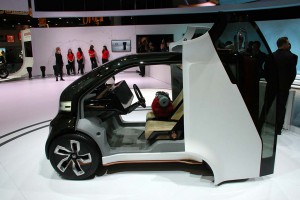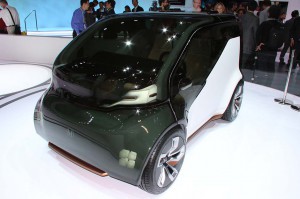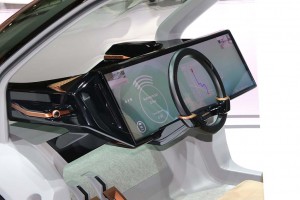Millions of people are already using ride-sharing services like Uber and Lyft, and the numbers are expected to grow exponentially over the coming decade.
Drivers currently use their own vehicles, though General Motors and several other companies are pushing to get specific models, like the new Chevrolet Bolt EV into these ride-sharing fleets. Now, Honda is going a step further. At the Consumer Electronics Show in Las Vegas, it’s showing off a pint-sized battery-electric vehicle designed primarily to serve as a ride-sharing vehicle.
Dubbed NeuV – pronounced noo-VEE, and short for New Urban Electric Vehicle – this autonomous two-seater is targeted for those living in dense urban environments who typically don’t drive great distances and likely leave their vehicles parked much of the day.
“We designed NeuV to become more valuable to the owner by optimizing and monetizing the vehicle’s down time,” explained Mike Tsay, the principal designer for Honda R&D Americas, where NeuV was developed.
(Sneak peek: Click Here for an advance look at the vehicles debuting in Detroit next week.)
While you’re at work, NeuV, with its unusual scissor doors, could be out there working for you. In driverless mode, it could be plugged into a ride-sharing service’s network picking up fares. And so you don’t wind up with the battery gauge on empty at the end of the day, NeuV can charge up wirelessly, simply rolling onto one of the pads Honda (and several other makers) anticipate could be placed around urban parking lots – even city streets – in the not-too-distant future.
Whether it’s cruising around with its owner or a ride-sharing customer, NeuV can do more than just drive. The concept vehicle is equipped with a digital personal assistant, Honda’s answer to Siri, Cortana and Alexa. Named HANA – short for Honda Automated Network Assistant – “she” can do many of the same things those other AI systems can handle: answering questions, plugging destinations into your navigation system, or changing music to your favorites tunes.
But HANA can handle some other, more unusual tasks. For one thing, using vision and other sensors, Honda claims this artificial intelligence, or AI, assistant has a built-in “emotion engine.”
HANA, it seems, can read your emotions, sense your behavior, and watch how you’re driving. If need be, it can make recommendations – time to pull over for coffee – adjust the vehicle’s lighting to create a different mood, or even switch on a peppy soundtrack to keep you alert and focused.
That may seem a bit far-fetched, but several vehicles already can watch to see if a driver is getting drowsy, issuing an alert to get some rest. And a number of carmakers are working up production versions of the new crop of digital assistants. In fact, one of Ford’s big announcements at this year’s CES is the integration of Amazon’s Alexa into its latest-generation Sync infotainment system.
(For more on Ford’s infotainment plans, Click Here.)
Getting back to Honda, if a car that can earn you money and help improve your mood isn’t enough, the little battery-car can also help you avoid those excess downtown parking fees. Instead, you can park on the outskirts of town, reach into NeuV’s cargo compartment and pull out an electric skateboard-like contraption that would be used to travel the last mile.
NeuV is just one of the announcements from Honda at this year’s CES.
The maker also rolled out a prototype motorcycle that can balance itself when you come to a stoplight, for example. (BMW recently revealed a similar concept as part of its centennial celebration.)
Separately, the Honda show stand features a variety of high-tech concepts, displays and simulators. Meanwhile, the carmaker announced a new partnership pairing its Honda Developer Studio and Honda Silicon Valley Labs with Visa and DreamWorks Animation to help encourage start-ups focused on cutting-edge automotive technologies.
(Click Here to check out how Toyota is trying to “humanize” its new Concept-i.)



